On View
From a Chilling Kanye Rant to a Real-Life Children’s Commune, Artists Spin Work From Unexpected Sources at the Refreshed Art Berlin
5 works that caught our eye at the Berlin fair.
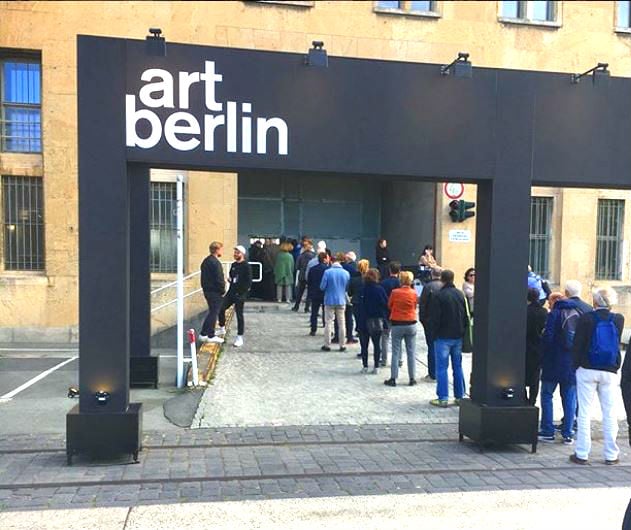
5 works that caught our eye at the Berlin fair.

Kate Brown

In its first year taking over two of Berlin’s historic and airy hangars at Tempelhof airport, art berlin feels revitalized with a new curated section, an array of solo presentations, and a special curated booth courtesy of another art fair, Brazil’s ArtRio. Some 114 exhibitors were present this year, making the fair slightly larger than previous editions. And yet, even as VIP guests drank wine around a sculpture garden on an airport tarmac, it all retained a comfortably familiar feeling.
The fantastic new space came at a scheduling cost, as art berlin moved from its usual slot at the beginning of September in order to nab the venue, creating a clash with two other events on the international fair circuit, viennacontemporary and EXPOChicago. Many gallerists are jumping right over to London for Frieze as art berlin comes to a wrap on Sunday; one gallerist said he was flying between Vienna and Berlin over the next few days to be present for his collectors at both booths. Another grumbled about “collector fatigue.”
Other participants, like Austrian galleries Christine König, Elisabeth & Klaus Thoman, Gabriele Senn, and Charim, found a smart solution. They shared a well-curated booth together at the Berlin fair since they all could not be present.
The technical difficulties of the art world’s over-populated fair schedule should all be ironed out next year when the fair returns again to Tempelhof at its original date earlier in September. In the meantime, this year the art itself manages to stand out in these naturally lit hangars. Here are some of the particularly captivating presentations on view by emerging international and homegrown talents.
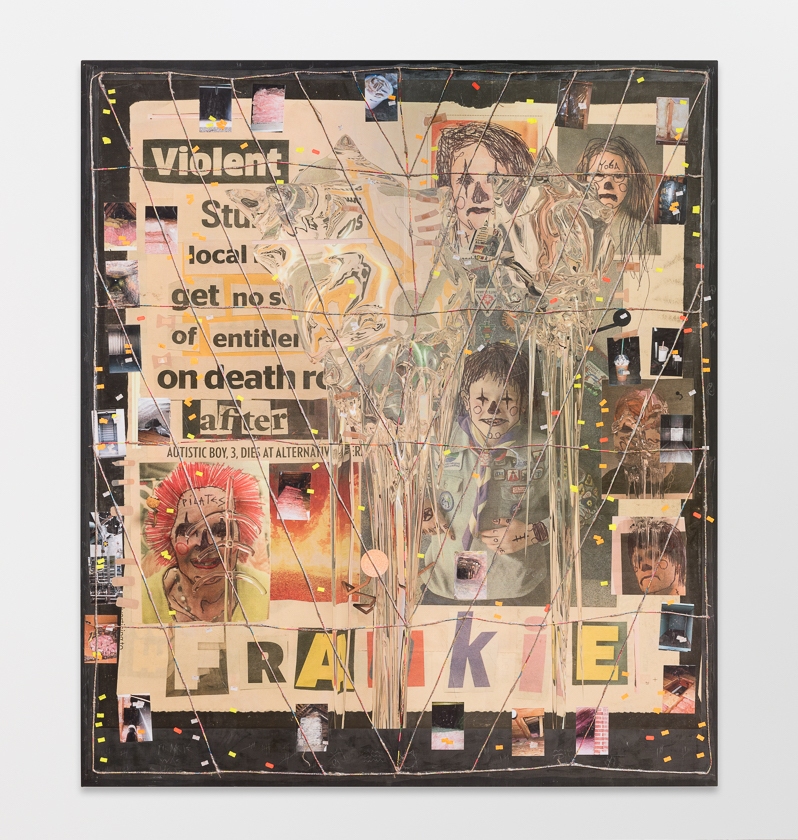
Jesus never bought me smokes, man (2016). Courtesy Emalin, London.
A subtle psychosis lurks in the paintings of London-based artist Nicholas Cheveldave. They suggest the obsessive hobby-ism of a scrapbooker, the innocent time-wasting of a young girl, and the frenzied clippings of a ransom note—all co-existing in his multiple layers of collage. The presentation at art berlin also marks a first participation in the fair for his gallery Emalin, a nomadic exhibition space that recently touched down in London with a permanent space.
Cheveldave’s four highly processed works on canvas on view are technically proficient treatments of photography, painting, and digital rendering. The work involved in them belies the very low-brow, tabloid-reading mass culture reference points that the artist affectionately embraces and elevates. Figuration is distorted and many elements have been overlaid, not with paint but with scraps of consumer culture: discount price tags, home renovation snapshots, etc.
Everything is delightfully rowdy, even as the traditional elements of painting are all well balanced.
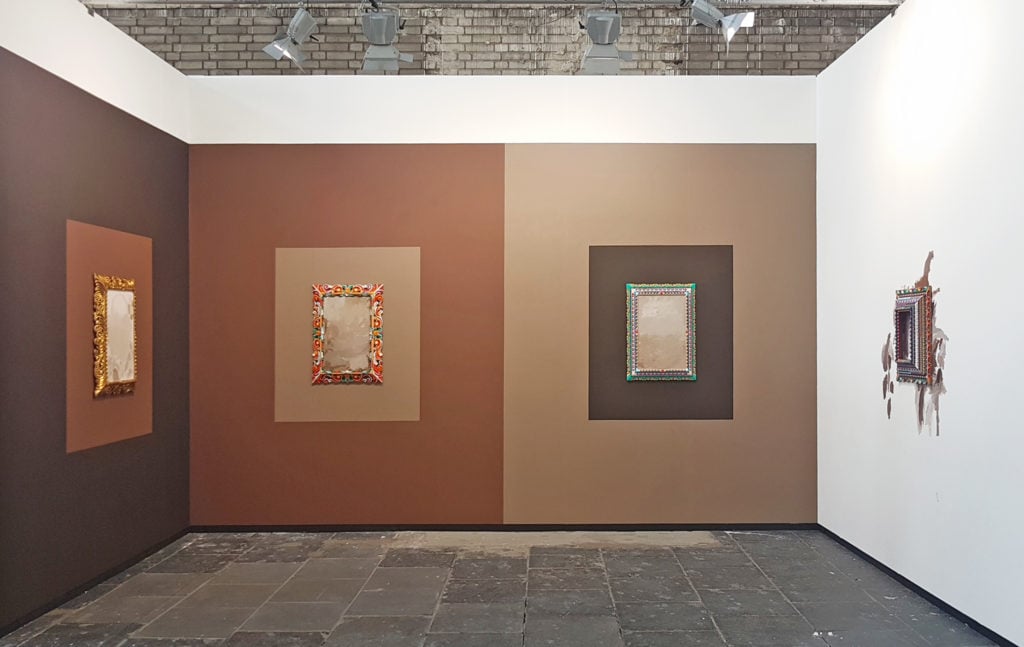
Tente en el aire, 2018. Courtesy the artist and Barbara Gross Galerie, Munich.
Berlin-based Venezuelan artist Sol Calero has changed gears with her newest body of works. Her painting practice is still rooted in her interest in playing with the clichés and exoticism ascribed to Latin American art, but Calero’s new paintings have done away with the pattern-like still-life fruit and flora displays she was known for. Likewise, she has left behind her multi-colored installation works that used spaces like Latin shopping centers or a travel agency as a jumping off points. Instead, her new works are strikingly abstract and non-iconic.
With Munich-based Barbara Gross’s elegant presentation at art berlin, Calero introduces a new theme: race. The work Tente en el aire (translated “hold yourself in midair”) features various skin tones of brown spread across canvas on the wall, framed by intricate handmade frames that the artist collected in Peru. Calero then painted them in gold and bright colors to frame her non-figurative portraits.
The work references colonial era “Caste Paintings” that were made in the same area where she acquired the frames. These artifacts were an artistic tool used to illustrate and promote categories of race, using Euro-Christian painting traditions to enforce social structures in the colonies.
Calero does away with any figuration, instead bringing the underlying issue down to its barest elements: racial classification hidden within a gilded frame.
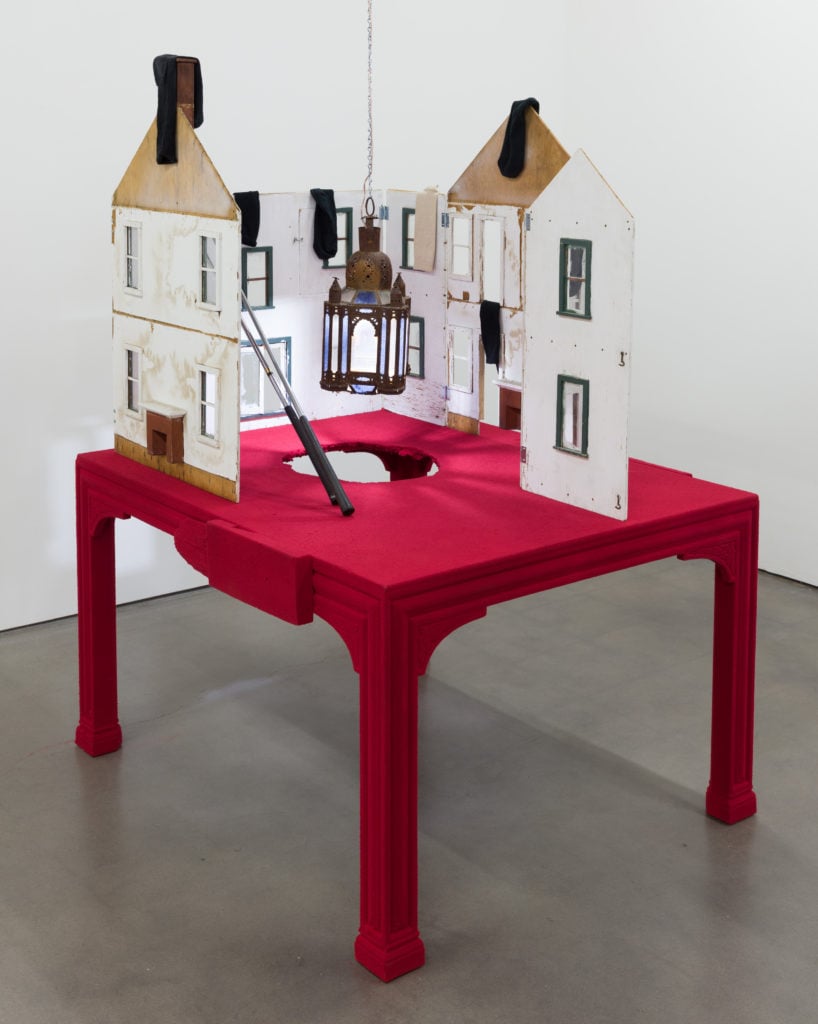
EUROZONE (2017). Photo: Michael Underwood. Courtesy the artist and Freedman Fitzpatrick Los Angeles/Paris.
Munich-born Mathis Altmann seems to continually strike a fine balance between a freewheeling readymade and precisely crafted sculpture. That’s not an easy thing to do, but the artist, who is based between Los Angeles and Zurich, manages this harmony especially well for his work on view at Freedman Fitzpatrick, the gallery’s debut participation at art berlin.
A plush table called EUROZONE stands like a centerpiece for the group presentation that surrounds it, which includes new works by Jill Mulleady and Amelie Von Wulfen, among others. On top of his red pedestal stands an abject-looking dollhouse, pierced through the middle with golf clubs.
“Dollhouses are dream houses,” writes the artist in a press release about the series for a recent show at the gallery. “They remain the ultimate reflection of middle class desires: buying, owning, developing, privatizing, and protecting properties that reflect our heritage throughout the generations, to be smeared in infants’ faces at the earliest possible stage.”
Out of a window, on the chimney, and on its roof hang single black dress socks. A lantern burns in the middle, precariously dangled above a carved-out hole. Everything is wonderfully useless, emptied out, and kitsch.
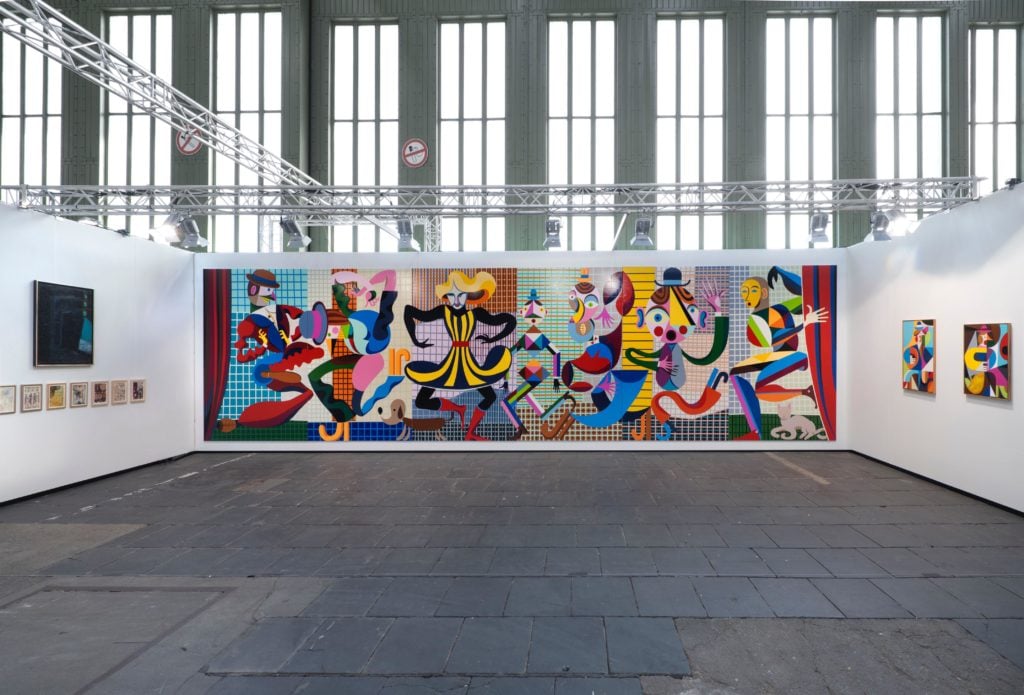
Gaudiopolis (2018) by Christoph Ruckhäberle. Courtesy Galerie Kleindienst.
The multi-paneled but singular painting by German painter Christoph Ruckhäberle might just be the largest work on canvas at the fair this year. At any rate, it’s a show-stopper. Called Gaudiopolis, the work continues with the Leipzig-based painter’s interest in youth and bohemia, blending socialist realism, folk art, and German expressionism together in hyperbolic tones. There is something almost religious in the artist’s dancing figures, made from simple geometric forms framed by curtains and a gridded background.
The monumental painting on view at art berlin cracks open the door on the fascinating history of a self-administering children’s republic, called Gaudiopolis, that was formed in Budapest, Hungary following the devastation of World War 2. The republic took in hundreds of orphans after the war, regardless of religion, social background, or nationality. Housed in former villas and initiated by Lutheran pastor Gábor Sztehlo, the children wrote their own constitution, which included the right to education and the prohibition of war. The playfulness and utopic dreaming present in Ruckhäberle’s work belies the tragedy and horrors that the children endured.
The work was presented earlier this year in a group exhibition at Leipzig’s Contemporary Art Museum, organized by Franciska Zolyó (curator for the German Pavilion at next year’s Venice Biennale) and titled “Gaudiopolis—Attempts at a Joyful Society.”
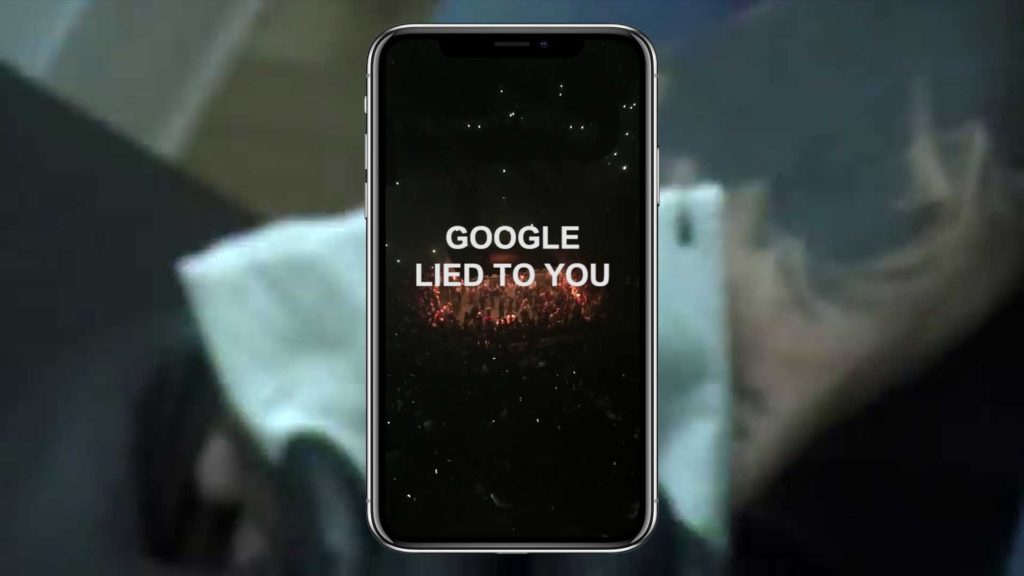
Video still from Only Originals (Detail) (2018). Courtesy of the artist and Galerie Conradi.
Kanye West is the focal point for German artist Steffen Zillig’s two-screen video work, Only Originals, on view within a group presentation at Galerie Conradi. Editing video footage from West’s infamous rant during a 2016 Sacramento concert, Zillig’s pared-down film is a heavy and at times upsetting video; it is also an immensely powerful comment on how the Internet, as a viewing arena, creates a world where extremity becomes normalized and where reason and logic collapse.
Zillig includes West’s inflammatory speech almost in its entirety with subtitles, because he wants to make sure you really listen. The gallery even has headphones available in case you care to listen even more closely, though it plays on speakers anyways. “If you don’t got an iPhone, don’t put it up. Only originals,” screams West as a confused crowd. “A lot of people here tonight felt like they lost. You know why? Because y’all been lied to. Google lied to you. Facebook lied to you.”
West then goes on to talk about the inspiration he takes from Trump. The Kanye footage is intercut with sometimes startlingly violent videos of people doing extreme things to each other on YouTube, like choke-outs or inhaling strange substances to see the effects, overlaid with disoriented samples of trap music. The effect is to outline a world where self-aggrandizement and desire to be known is what unifies us, regardless of political background, race, or celebrity status.
art berlin runs from September 27 through 30, 2018 at Flughafen Tempelhof at hangar 5 and 6, at Tempelhofer Damm 45, 12101 Berlin.